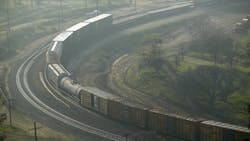Analysis
The fallout from the Norfolk Southern (NS) derailment in East Palestine, Ohio, quickly spread far beyond the topics of railroad safety practices and regulation to encompass operational management and financial practices at the nation’s largest freight railroads. This has resulted in the introduction of broad new railroad legislation, heightened scrutiny of a major rail merger, and launched the immediate prospect of new rail safety regulations—and the end assuredly is not in sight.
Not long after Norfolk Southern announced an extensive new safety program, the Association of American Railroads (AAR), which is made up of North America’s Class 1 railroads, launched its own program that applies to all of its members. The sheer ambition of the plan gives an indication of how the Ohio incident is reshaping public and political attitudes toward the rail industry.
In the immediate aftermath of the incident, Transportation Secretary Pete Buttigieg seemingly belittled its importance by pointing out in public comments that railroads experience more than a thousand derailments each year. By contrast, the AAR safety plan announced a goal of zero accidents and injuries, embracing a zero-based approach that has been adopted over the past 30 years by policymakers and government officials in Europe and United States in regard to traffic safety on roads and highways.
It is an approach that was previously endorsed by the Federal Highway Administration (FHWA) to apply to road design and the National Highway Traffic Safety Administration when addressing vehicle design. Soon after she took office, it was endorsed by National Transportation Safety Board (NTSB) Chair Jennifer Homendy. Later, following the Ohio derailment she declared at a press conference that, “I can tell you this much: This was 100% preventable. We call things accidents. There is no accident. Every single event that we investigate is preventable.”
Look for the Federal Railroad Administration (FRA) to act as well. Some reports have said the NTSB believes bearings in railcar wheel assemblies overheated, causing the fire. One rail union blamed the railroad’s failure to adequately maintain remote sensors place along the track responsible for locating and reporting overheating bearings (also called hotboxes), and all but one were found not to be working.
As a result, FRA issued an advisory warning railroads to evaluate their policies and procedures related to the use and maintenance of hot bearing wayside detectors, referencing a series of specific hazardous materials derailments going back to 2015. In addition, the agency announced on March 2 that it would conduct a nationwide inspection of rail lines that are used by high-hazard flammable trains (HHFTs) and those hauling large amounts of hazardous materials.
Railroads can expect more action after it was discovered that there were no existing federal regulations pertaining to the design and operations of these remote sensors.
Congress Enters the Fray
As expected, Congress quickly entered the fray as well, with as small bipartisan group of senators introducing legislation aimed at improving rail safety. “Through this legislation, Congress has a real opportunity to ensure that what happened in East Palestine will never happen again,” said Sen. J.D. Vance (R-Ohio), who introduced the bill along with Sen. Sherrod Brown (D-Ohio).
The Senate measure would boost fines for safety violations and stiffen the safety standards set for trains carrying hazardous materials and make rail car inspections more frequent. In adherence to rail union wishes, the bill also would ensure that trains carrying hazmat shipments have two-person crews, and address outstanding issues surrounding sick leave for rail workers.
Testifying at a Senate hearing on the legislation held on March 9, NS Chief Executive Officer Alan Shaw reportedly declined to endorse all of the provisions of the bill, but offered, “we are committed to the legislative intent to make rail safer.”
Although no one has yet to be able to firmly establish a direct link between the major railroads’ extreme cost-cutting operations model called Precision Scheduled Railroading (PSR) and deterioration of safety, critics including rail labor unions have blamed inadequate sick leave for exhausting rail workers and degrading safety. This was traced directly to the slashing of tens of thousands of workers from railroad payrolls that was practiced under PSR starting six years ago.
Rail workers’ ire over the sick leave issue came close to shutting down the nation’s rail system in a threatened strike just before Christmas of last year, which thrust the issue into public consciousness. Since then, the lingering bad feelings and negative publicity generated by the sick leave issue and possible strike also caused NS and CSX to negotiate expansion of the leave with two unions. The NS agreement negotiated with two unions was announced just three days following the Ohio derailment.
In addition, the rail safety issue arose in the opposition voiced by Sen. Elizabeth Warren (D-MA) in the weeks prior to the Surface Transportation Board (STB) approval of a merger of Canadian Pacific (CP) merger with Kansas City Southern (KCS). Before the board acted to okay the merger, Warren urged the board to block it, stating that it would cause an “adverse impact on competition, service disruptions, jobs and rail safety.”
About the Author

David Sparkman
founding editor
David Sparkman is founding editor of ACWI Advance (www.acwi.org), the newsletter of the American Chain of Warehouses Inc. He also heads David Sparkman Consulting, a Washington D.C. area public relations and communications firm. Prior to these he was director of industry relations for the International Warehouse Logistics Association. Sparkman has also been a freelance writer, specializing in logistics and freight transportation. He has served as vice president of communications for the American Moving and Storage Association, director of communications for the National Private Truck Council, and for two decades with American Trucking Associations on its weekly newspaper, Transport Topics.
